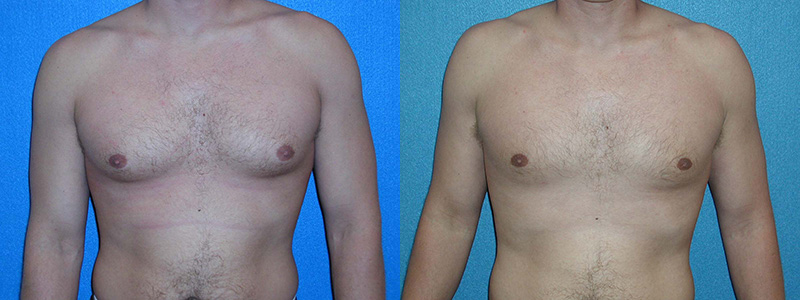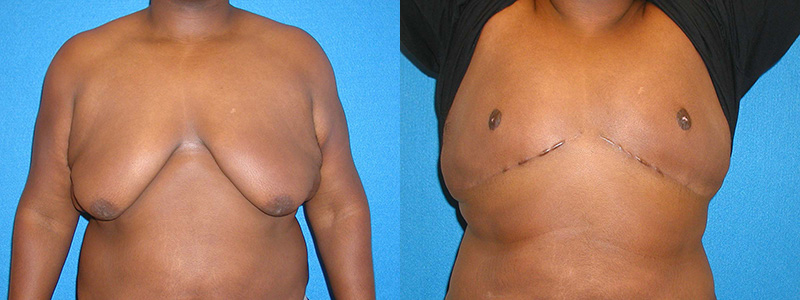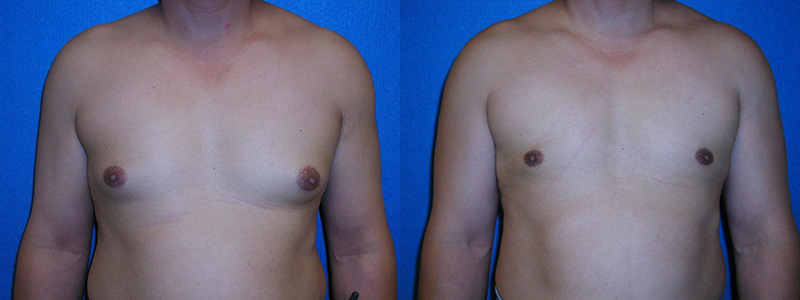What Gynecomastia Surgery Can Achieve:
Gynecomastia Surgery Options
Undergoing gynecomastia surgery can have a tremendously positive impact on your build and self-esteem. By thoroughly evaluating your condition and developing a personalized surgical plan to fulfill your needs, Dr. Scott Green ensures that you receive superlative care and an exceptional enhancement experience.
Excision
Liposuction
• Laser-assisted
• Ultrasonic-assisted
• Tumescent
Because of the customizable nature of this procedure, the most appropriate liposuction technique for your condition will be determined during your private consultation.
Gynecomastia Surgery Concerns
Recovery
Gynecomastia surgery patients are likely to experience some swelling and discomfort following the procedure. Patients are encouraged to rest during the initial stage of recovery, but they are advised to walk around the house to promote adequate circulation and healing. Patients should avoid vertical arm movement for at least two weeks. Moderate exercise can be resumed when the surgeon approves it, which is usually around three weeks after surgery.
Scars
Gynecomastia surgery may result in some scarring. However, any scars are likely to fade over time. Treatment using silicone strips or silicone-based topical cream can help minimize the appearance of scars. Patients are also advised to avoid sun exposure for six weeks to prevent the darkening of their gynecomastia scars.
Cost
The cost of gynecomastia surgery depends on several factors including (but not limited to) surgical technique, the extent of correction required, and anesthesia fees. During your consultation, Dr. Green’s financial coordinator will give you an accurate cost estimate for your customized procedure.
Pain
While most patients report soreness after gynecomastia surgery, the pain is mild to moderate. Patients can manage discomfort during the first few days of recovery with oral pain relievers as advised by Dr. Green.

The Art of Plastic Surgery
Surgical skill can be learned, but surgical artistry is something a person must be born with. Dr. Scott Green has the inherent aesthetic and anatomical understanding necessary to deliver results of utmost transcendence to all of his patients. By applying his irrefutable grasp of beauty and state-of-the-art surgical techniques, Dr. Green sculpts his patients’ contours for the most dazzling and customized outcome.
“Every block of stone has a statue inside it, and it is the task of the sculptor to discover it.” – Michelangelo di Lodovico Buonarroti Simoni
Gynecomastia Videos



Frequently Asked Questions
-
How do I prepare for my gynecomastia surgery?
In the two weeks leading up to your surgery, you should avoid sunbathing, hair removal treatments, blood thinners, and herbal supplements. Before your procedure, it is also wise to obtain your compression garments, complete major household chores, fill your prescriptions, and arrange for a friend or relative to drive you to and from the surgical facility.
-
How long after undergoing gynecomastia surgery can I return to work?
Most patients can resume working after one week of recovery. However, those with physically demanding jobs should wait at least two weeks before returning to work.
-
Should I quit smoking before undergoing gynecomastia surgery?
Yes. Smoking and tobacco use hinders proper healing and circulation. To reduce the risk of post-op complications, patients should avoid all tobacco use for at least three weeks before and three weeks after their scheduled procedure.
-
How long will my gynecomastia surgery results last?
As long as you adopt a healthy, active lifestyle, the effects of your gynecomastia procedure are considered permanent. Avoiding steroid use can also help prolong the outcome of your surgery.
-
What are common misconceptions about gynecomastia?
Many believe that gynecomastia is simply a result of poor diet and lack of exercise, but it can also stem from hormonal imbalances, genetics, and certain medications. Another misconception is that only overweight men experience it when, in fact, men of any weight can develop gynecomastia.
-
What are the stages of gynecomastia?
 Gynecomastia is classified into several stages based on glandular development and skin excess:
Gynecomastia is classified into several stages based on glandular development and skin excess:- Grade I: Small enlargement without skin excess.
- Grade II: Moderate enlargement without skin excess.
- Grade III: Moderate enlargement with extra skin.
- Grade IV: Marked enlargement with significant skin excess, resembling feminine breast ptosis.
The type of gynecomastia often helps to determine which surgical approach is best for making cosmetic improvements.
-
Are there any restrictions on activity after surgery?
Post-surgery, it’s important to limit physical activity to promote healing. Avoid strenuous activities and heavy lifting for at least three to four weeks. Light walking is encouraged to reduce the risk of blood clots. Follow specific guidelines provided by Dr. Green to have a smooth recovery without significant discomfort.
-
How do I care for surgical sites post-operation?
Keep surgical sites clean and dry. You’ll typically wear a compression garment to reduce swelling and support the new chest contour. Follow Dr. Green’s instructions on how to care for drains if they were placed; and attend all follow-up appointments to ensure proper healing.
-
Can man boobs grow back after surgery?
While gynecomastia surgery removes fat and glandular tissue, new excess tissue can develop if the underlying cause isn’t addressed. Maintain a stable weight and avoid drugs known to induce gynecomastia. Regular follow-ups can help monitor and address any changes early. Our team works with patients to identify the likely root causes ahead of surgery so we can offer long-lasting results.
-
Do I have to lose weight before surgery?
It’s not usually a requirement. If you are significantly overweight, Dr. Green may recommend reaching a stable, healthy weight before surgery to optimize results and minimize risks. Weight loss can reduce the fatty component of gynecomastia, but glandular tissue, which often requires surgical intervention, typically remains unchanged by weight fluctuations.
-
Is gynecomastia surgery covered by insurance?
Although there are exceptions, gynecomastia is generally classified as an elective cosmetic procedure and is therefore not covered by most medical insurance plans. Fortunately, financing plans are available at Dr. Green’s office to help patients better afford their care.
-
How long does it take to see the final results of gynecomastia surgery?
 The initial recovery period for gynecomastia surgery is generally four to six weeks, during which significant swelling and bruising will decrease. However, the final results of the surgery may take several months to fully manifest as the body adjusts and settles into its new contour. Patients may notice gradual improvements during this period. It’s important to follow all post-operative care instructions and attend follow-up appointments with Dr. Green to ensure the best outcome. The visibility of scars, which can take up to a year to mature and fade, will also improve over this time.
The initial recovery period for gynecomastia surgery is generally four to six weeks, during which significant swelling and bruising will decrease. However, the final results of the surgery may take several months to fully manifest as the body adjusts and settles into its new contour. Patients may notice gradual improvements during this period. It’s important to follow all post-operative care instructions and attend follow-up appointments with Dr. Green to ensure the best outcome. The visibility of scars, which can take up to a year to mature and fade, will also improve over this time.